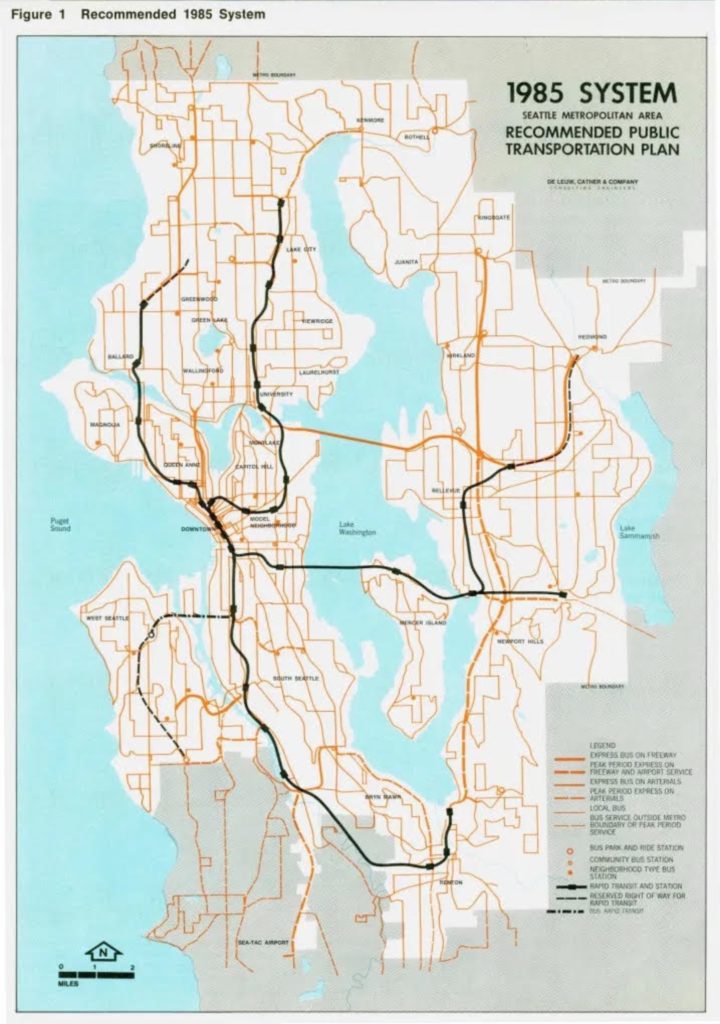A “Hooverville” encampment during the ’30s in Seattle
By Larry Coffman, publisher
I’ve been asked several times why I’ve taken such an interest in the homeless/lawless crisis that’s raging in Seattle (see series of prior posts below). Eric Johnson’s chilling documentary on KOMO-TV—Seattle Is Dying—clearly was the trigger for my interest. But the complete answer requires that I share is bit of personal backstory…
 In 1968, Jim Ellis spearheaded an unprecedented 12-part capital-improvement program in King County that he dubbed “Forward Thrust.” Seven of the 12 propositions were approved by voters, and the benefits that flowed from the program included new fire stations, road improvements, parks and swimming pools, the downtown aquarium and the late Kingdome.
In 1968, Jim Ellis spearheaded an unprecedented 12-part capital-improvement program in King County that he dubbed “Forward Thrust.” Seven of the 12 propositions were approved by voters, and the benefits that flowed from the program included new fire stations, road improvements, parks and swimming pools, the downtown aquarium and the late Kingdome.
Unfortunately, the proposal for the $1.1 billion rail-rapid-transit system, to be built and run by the former Municipality of Metropolitan Seattle (Metro), was one of the four measures that failed. Although it received just over 50% of the votes, a 60% majority was required, because the local funding was based on property tax.
 I was hired by Ellis and then-Seattle-Mayor Dorm Braman in late 1968 as the first employee of the new Metro transit function, activated to resubmit the issue to the ballot in 1970, because Senator Warren Magnuson had secured $800 million in federal funding that was earmarked for Seattle, pending voter approval of the project.
I was hired by Ellis and then-Seattle-Mayor Dorm Braman in late 1968 as the first employee of the new Metro transit function, activated to resubmit the issue to the ballot in 1970, because Senator Warren Magnuson had secured $800 million in federal funding that was earmarked for Seattle, pending voter approval of the project.
My job was to staff the technical committee working on refining the plan for a 50-mile/four-legged system, designed to be completed by 1985, and to manage the subsequent campaign to resubmit the issue to the voters. Unfortunately, the infamous Boeing Bust coincided with the election, and the funds earmarked for Seattle were redirected to help build what is today Atlanta’s MARTA transit system.
Many long-time Seattleites rank the Great Seattle Fire of 1889 and failure to approve rail-rapid-transit—in two tries—as easily the worst setbacks in Seattle’s history. The result of our failure to get a jump on transit-building is reflected in today’s periods of near-gridlock and the addition of untold billions of dollars in construction costs.
One big anti-argument in the 1970 election was that Seattle would not become a headquarters city—and thus not increase sufficiently in density—because most of the future development would be concentrated in the suburbs. Boy, did the UW geographers who were our adversaries ever get that one wrong!
The other big argument was that if we, indeed, built the then-leading-edge transit system, it would be too much of an encouragement for people to move to Seattle. Ironically—and unfortunately—we’re hearing that same argument against cleaning up the homeless/lawless crisis.
Oddly enough, there has been little talk of the “Hooverville” and “Nickelsville” homeless encampments in the city’s past. My concern is that the current homeless crisis is far more pervasive than those previous versions and will be far more difficult to resolve, due to the “perfect storm” of drug addiction, mental illness and housing prices that is driving today’s version.
Our recent poll showed that readers are surprisingly optimistic about the potential to end the homeless/lawless crisis. Polls on the 1968 and 1970 transit issues were positive, too.
But bad things are said to happen in threes. Hopefully, we can avoid a double dose. First, by preventing the homeless crisis from becoming Seattle’s third major setback—and perhaps the worst of all, in human terms. And second, by avoiding becoming known as “Seattleville”—the logical successor to “Hooverville” and “Nickelsville.”
Being personally involved in one of the two worst setbacks in Seattle history is enough! And it will sustain my interest in helping resolve the homeless/lawless crisis—and making Seattle a model for other cities to copy.
P.S. Here are links to prior posts in the fantastical Action Central series: Mayor Durkan’s Address; Homeless Central, a First Step; background on Action (nee Homeless) Central director John Shannon; his distinction between Homelessness and Lawlessness; The Stakeholders; The Perfect Site!; ‘Jigsaw Puzzle’; Reaching For Reality; Town Hall Takeaways; Eric’s National Exposure; ‘Head Chef’; ‘Our Mission Control’; The No. 1 Deliverable—Synergy!; Proactive Vs. Passive; Action Central: Guest Proposal-Part I; Action Central: Guest Proposal-Part II; Action Central: Guest Proposal-Part III; Homeless/Lawless Quiz Results+ and Call For A Homeless ‘Czar.’







Larry, old friend, since leaving Seattle in 2000 and settling in the East Texas Outback on 30-acres, many things have come into perspective, particularly on this rhymes of Hooverville’s past. In fact, just finishing a book on it which should be on Amazon shortly “The 100-year Toaster.”
I’d offer that what we’re going through is essentially another “asset-stripping” of America. That is, anything that individuals have is slowly being “governmentized.” In fact, to the point that in some places (Ohio and the rust belt come to mind) people are discovering that they no longer own their own homes; when total tax burdens exceed 10% does anyone own their own fate?
Thus the “100-year Toaster” problem. We can live in a world where unit costs are lowest and life-cycles are optimized to be as short as possible. OR we can stop the madness of making “disposable everything” and return to life-time goods.
Last glass of champagne at the old 6th Ave Motor Hotel I was on my sailboat. Sold it, but still have the same Corelle Winter White dishes 35-years later.
That’s the heart of the paradox, my friend. Disposable products bring disposable people as a consequence. And if we don’t start taxing robotics, the wealth disparity will only get worse.
Cheer my brother from the Texas tall timber country.
George Ure (Garrett in bcst days)
Palestine, Texas
Comments are closed.